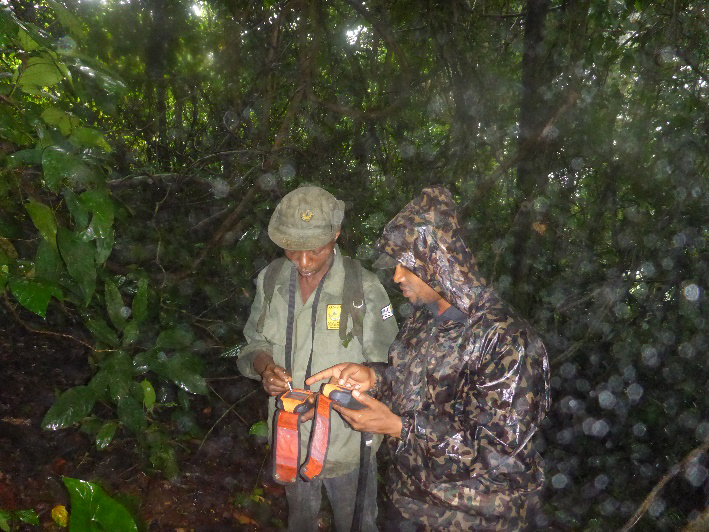Improving Law Enforcement Monitoring in the Afi Mountain Wildlife Sanctuary
Categories: Journal no. 52, Protective Measures, Nigeria, Afi, Cross River Gorilla, Gorilla Journal
The Afi Mountain Wildlife Sanctuary (AMWS) in Nigeria is the western-most Cross River gorilla site and home to about 10 % of the total Cross River gorilla population (Dunn et al. 2014). Due to previously poor protection, levels of hunting and other human activities in the sanctuary are high. However, basic support for ranger patrols, new partnerships and improved monitoring technology has helped reduce hunting in AMWS from 2.07 wire snares per km in 2012 to 0.53 wire snares per km in 2015.
In 2011, with support from the US Fish and Wildlife Service, WCS in collaboration with North Carolina Zoo helped reorganize and reinvigorate the ranger program at Afi, introducing an improved law enforcement and wildlife monitoring system based on CyberTracker (a software that can be used on a handheld computer or Smartphone to record automatically georeferenced observational data). This new system allowed more efficient anti-poaching patrol planning and monitoring and has significantly improved law enforcement effectiveness. Building on the success of the CyberTracker system, WCS in collaboration with North Carolina Zoo introduced SMART (Spatial Monitoring and Reporting Tool) at Afi in late 2015. SMART is a new and improved tool for measuring, evaluating and improving the effectiveness of wildlife law enforcement patrols and site-based conservation activities. SMART has improved data analysis, intelligence and planning and automated reporting functions compared to CyberTracker.
During 2015 with support from WCS, Cross River State Forestry Commission (CRSFC) rangers completed 47 long-distance foot patrols of the AMWS. The patrols which also covered the adjoining Olum Hills and Kakwagom-Bitiah community forest covered a total distance of 1,830 km.
Levels of hunting were high both within the sanctuary and in the adjoining areas. Six hunters were apprehended, six shotguns and 1009 wire snares were confiscated, and 45 hunting camps were destroyed. With an improved law enforcement monitoring system hunting in AMWS (measured as encounter rate of wire snares and hunting camps) has continued to decline. However, hunting with wire snares and shotguns is still widespread in AMWS and remains a major threat to the wildlife including gorillas. Although protected by law, Cross River gorillas are still occasionally hunted, especially at sites where protection is weak.
In addition to hunting, the survival of the Afi gorillas is threatened by habitat loss due to farming and logging. Many new farms and evidence of illegal logging were discovered within the sanctuary and in the Olum Hills and Kakwagom-Bitiah forest by rangers during patrols in 2015. Although most of the farms within the sanctuary were located around the boundary, many were expanding deeper into the sanctuary threatening to destroy much of the sanctuary soon if not checked. Urgent action is needed to tackle the issue of illegal farming and logging within the sanctuary and in the adjacent Afi River Forest Reserve to protect the habitat corridor linking the AMWS to the Mbe Mountains and the Okwangwo Division of Cross River National Park. In addition to law enforcement, increased community support and participation is essential for the long-term protection of Afi.
Reorganizing the ranger programme at Afi based on the CyberTracker system (and now SMART) has proved to be a worthwhile endeavor with encouraging results already recorded. The ability to gather geo-referenced field data quickly and analyze and share information simply and in a timely manner is a key strength and advantage of the system. The system has enhanced monitoring of wildlife, threats and law enforcement performance. By making it easy to direct patrols to hotspots of human activity recorded by previous patrols and keeping rangers accountable the system has enhanced patrol planning and effectiveness, much needed to significantly reduce the hunting threat at Afi and keep the gorillas safe. In collaboration with North Carolina Zoo, WCS has also introduced CyberTracker and SMART at other Cross River gorilla sites in both Nigeria and Cameroon.
During these patrols gorillas were observed directly on two occasions and a total of 21 gorilla nest sites, 2 chimpanzee and 3 unidentified nest sites were recorded. The presence of gorillas was also recorded in the Olum Hills, but not in the Kakwagom-Bitiah forest where levels of human activity including hunting, farming, and logging were especially high. The presence of gorillas had been previously recorded in the Kakwagom-Bitiah forest.
Though known to be used by gorillas, the Olum Hills and the Kakwagom-Bitiah forest have received little attention over the years. In 1997, the Olum Hills suffered substantial fire damage which forced the gorillas to abandon the area for about a decade. Evidence of their return to the area was recorded only in 2005 when the vegetation started to recover. In 2006, following reports of crop-raiding by gorillas in nearby farms in the Kakwagom-Bitiah forest, WCS conducted a survey which confirmed use of the area by gorillas, and noted the rapid loss of habitat in the area.
With the government often delaying payment of the salaries of the Afi rangers for many months, support from WCS and our donors and partners including North Carolina Zoo, Berggorilla & Regenwald Direkthilfe, the U.S. Fish and Wildlife Service, the U.S. Forest Service and Taronga Zoo, Kolmården Zoo, and Puma has been crucial to maintaining patrols to protect gorillas and other endangered primates at Afi.
Inaoyom Imong, Emmanuel Bassey, Andrew Dunn and Richard Bergl

